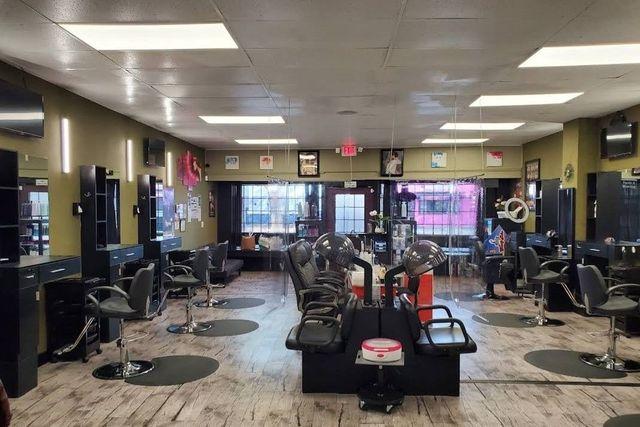Every six-to-eight weeks—that's how long most of us have been told is the magic number for how often we should be getting trims. And, honestly, we don't even know where we heard that information in the first place. While regular cuts are necessary for hair maintenance and reshaping, it can't possibly be a one-size-fits-all deal. What if we're rehabilitating damaged strands? Or want to maintain a super short crop with shattered angles? In theory, a six-week visit to the hairstylist might be fine, but there are certainly some exceptions to the rule depending on the hair texture and cut.
How to Know When It’s Time for a Hair Cut
When it comes to how often you should cut your hair in general, there's no one answer. But, depending on your hair and what your end goal is, there might be a sweet spot. "Two key factors when wondering [if it's] time for a cut are as basic as this: 1) Can you no longer achieve the styles you desire? And 2) are the ends of your hair visibly damaged?" explains Norton. Around a month after your last haircut, start asking yourself those questions. If you answer "yes" to either one, head to the salon. You may find that you can go months without having either of these issues and because of that, it may not be necessary for you to be getting as frequent trims– plus, it'll save you some time and money.

Do Frequent Trims Boost Hair Growth?
Cutting your hair may help it grow longer and faster, but not in the way you're thinking. Trimming the tips doesn't affect the root (which is where it grows from), but it does prevent your hair from suffering the breakage and split ends that make it look like it's growing slowly.
Short Hair
The experts suggest scheduling a trim between three and seven weeks for shorter cuts and bobs. According to Collins, if you have a specific style, like an Anna Wintour bob with bangs, then you probably need to get your hair cut every three weeks to keep the look precise and polished. "This is based on the fact that your hair usually grows about half an inch per month," he adds.
Norton agrees that more frequent trims are a must to maintain the style and shape of a shorter 'do. But if you're more relaxed about your look, then you may be able to stretch that to four or even up to seven weeks.
Medium-Length Hair
The pros say that getting a trim about three or four times a year should suffice. "If you generally have healthy hair that isn't damaged and you're keeping it mid-length to long, you need to cut it less," Collins says. "I recommend only three to four times a year just to dust the ends and touch up layers.”
Long Hair
Even those with long, healthy tresses need regular trims. Whether layered or all one length, most styles and cuts will completely lose their shape after a couple of months. And it's important to remember that long hair is very old. Like anything that ages, the older hair gets, the more fragile it becomes. Long hair is typically more susceptible to breakage, split ends, and to appearing thinner, especially if it has been chemically treated.1 The experts recommend visiting the salon every eight weeks.
Curly or Textured Hair
Hairstylists specializing in natural texture recommend at most 12 weeks between cuts. "Ideally, I would recommend six to 12 weeks for anyone with wavy or curly hair, while coil-y, tight curls and kinky patterns could wait as long as two months for a trim," François explains. "If your hair is colored or heat damaged, I would advise checking if the hair needs cutting every time you are having it colored to avoid over-processing the ends." Your colorist should be able to help you out here, too. Ask them whether it's time for a trim before they start the color process.
“Textured hair tends to be quite dry naturally and craves moisture,” François adds. As such, he recommends 12 weeks between cuts, but stresses the importance of time between washes: “The best number of days will vary from person to person, but every two to three days might be good for wavy hair; every three to seven days good for curly hair; and every seven days or possibly longer for coil-y and kinky hair.”
Fine Hair
Hair that's on the thinner side tends to be more damaged and breakage-prone, so you will benefit from more frequent cuts every four to eight weeks to keep ends clean. While "longer" straggly strands may technically be lengthier, they don't actually read as length and will contribute to hair looking unhealthy. Regular trims and freshly cut ends, on the other hand, will help your hair to appear healthier and fuller.
Damaged Hair
Collins suggests a trim every eight weeks if your hair is chemically damaged, especially fine, or frayed at the ends. More frequent haircuts can help prevent over-drying and breakage. This will also clean up split ends so hair looks healthier and sleeker while in the process of becoming stronger and healthier.
Exceptions
Most experts agree that anything under three or four weeks is too soon to be cutting hair, especially if growth is your ultimate goal. However, as with all rules, there are exceptions. Some high-maintenance styles like bangs, buzz cuts, cut-outs, or fades can require a refresh every two weeks or every other week. In these cases, it's best to check with your stylist for their recommendation on upkeep.
Haircut vs. Trim
While some may use the verbiage interchangeably (and then add context for clarity), there is a key difference between a haircut and trim—one that could lead to a completely different (and potentially disappointing) salon experience. A trim is a subtle refresh of your existing cut. If you request a trim, the stylist will likely ask how much you'd like to take off and execute in a fashion that generally retains the current shape of your style. An even more subdued iteration of a trim is a dusting, which only focuses on removing split ends and damaged bits—essentially only taking off the bare minimum. A haircut is much more drastic and involves changing the shape of your hair completely. For example, going from long tresses to an angled, shoulder-length lob. This should prompt several follow-up questions to hone in on your vision and leave you walking out of the salon with a different look than you walked in.
Cutting your hair may help it grow longer and faster, but not in the way you're thinking. Trimming the tips doesn't affect the root (which is where it grows from), but it does prevent your hair from suffering the breakage and split ends that make it look like it's growing slowly.
The Takeaway
Besides these timing tips, it's also important to read the telltale signs that your hair needs a trim. Split ends, layers losing shape, and hair that tangles easily (especially at the bottom) are some of these signs. No matter what, experts agree that you shouldn't wait more than six months for a haircut.













